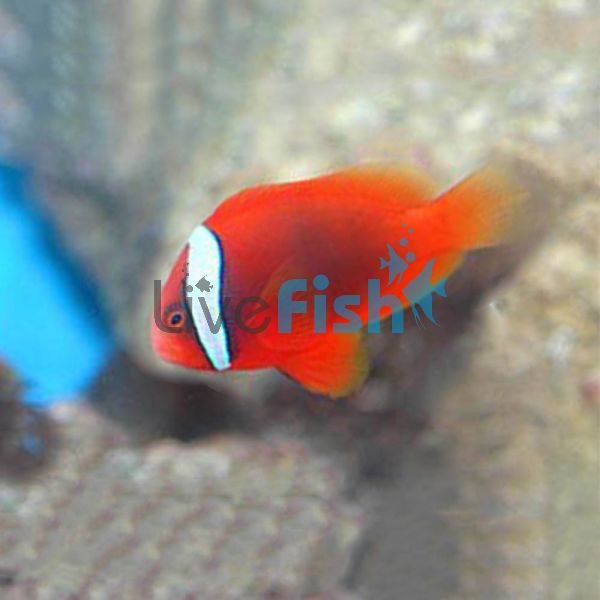Clownfish Tomato - Medium
The Clownfish is one of the easiest clownfish to take care of due to its hardy nature. This makes it an excellent choice for beginner aquarium owners to 'get their Nemo on'! A bit different from the standard Orange and white 'Nemo' Clownfish, the colouring of these clownfish can range from tomato red to vibrant orange.
- Buy 2 for $64.91 each and save 10%
- Buy 4 for $61.30 each and save 15%
Clownfish Tomato
The colouring of these clownfish can range from tomato red to vibrant orange. The males of the species typically maintain this brightness throughout adulthood. The females will darken with age, turning a slightly brown shade on the side. The most distinguishing feature has to be the white vertical stripe running through its head. The juveniles actually start with three bands that will fade into one predominant one.
These are some of the easiest species of clownfish to breed in captivity, and great success has been had in both the hatching and rearing of juveniles. What is interesting about these creatures is that they are all born sexless and will change into juvenile males based on social and environmental cues. The most dominant male will then transform into a female when there is an absence of one.
The Fire Clownfish has a symbiotic relationship with the Bubble Tip Anemone. The anemone provides shelter from predators due to the clownfish's seeming immunity to its stinging tentacles. In return, the clownfish will protect it from fish that prey on anemones.
This particular species of clownfish is originally found in the Western Pacific Ocean from Palau, Japan, and Indonesia across to the Gulf of Thailand. They inhabit shallow lagoon reefs and bays at depths of up to 12 metres. Usually, they will live inside a host Bubble Tip Anemone in adult male-female pairs, while the juveniles live solitary lives.
Tank Recommendations for the Clownfish Tomato
The smallest tank size for a single clownfish is 115 litres, but at least 160liters is needed when keeping as a pair. If an anemone is added, 180 litres is recommended, but these do come with their own set of requirements, so think carefully before introducing it.
Anemones are not essential to the survival of this species, and in the absence of one, live rock, coral, or other structures can be substituted. Lighting and water movement are not an issue, yet be sure to maintain at least one calmer area of the tank for feeding. Any substrate type is acceptable, and the Fire Clownfish will tend to stay in the same vicinity of its host anemone/coral/rock, only leaving it to feed and chase away other fish.
Suitable Tank Buddies
These fish can be very territorial and aggressive, and as such, should be kept with species that can hold their own against them. They will attack other clownfish and their own species, so unless they are a proven pair, keep them on their own.
Usually Compatible
Fire Clownfish will do well with large and dwarf species of Angelfish. Batfish, Boxfish, and Filefish will get along fine with them, too. Other good options to keep with them include Tangs, Parrotfish, and Grunts. Fire Clownfish can be housed with live coral and will only occasionally nip at them to clean the algae from around their base.
Sometime Compatible
Caution must be taken when attempting to keep Fire Clownfish with species such as Pufferfish, Triggerfish, and Wrasses. Success can sometimes be had when housing with Pipefish and Seahorses, but the tank must be large enough to have sufficiently spaced territories. Frogfish should watch carefully in case they get big enough to fit the clownfish in their mouth.
Rarely Compatible
Larger predators such as Groupers, Eels, and Lionfish should not even be considered as they will prey upon your beautiful new clownfish. Sharks, Snappers, and Scorpions will also most likely see them as dinner, too.
Feeding Your Clownfish Tomato
These fish are omnivores and, in the wild, will feed on algae, copepods, small crustaceans, and even fish eggs. In the tank, you will need to provide them with a diet of 50/50 plant and meaty foods. They may feed on some of the algae in your aquarium, but should be provided with pellets and flake foods that contain spirulina. Meaty options can include brine and Mysis shrimp, fresh or thawed marine preparations, and minced fish or shrimp flesh. Be sure to feed them 3-4 times daily with roughly the amount they can consume in about 3 minutes.
| Scientific Name | Amphiprion frenatus |
|---|---|
| Care Level | Easy |
| Common Names | The Clownfish is also known as the Fire Tomato Clownfish and the Red Clownfish. |
| Diet | Omnivore |
| Fish Family | Pomacentridae |
| Lifespan (years) | 17 |
| Max. Length (cm) | 14 |
| Min. Tank Volume (l) | 100 |
| Origin | Western Pacific Ocean from Palau, Japan and Indonesia across to the Gulf of Thailand |
| Reef Safe | Yes |
| Sociability | Semi-aggressive |
| Venomous | No |
| Water Conditions | Temp - 23-28° C, dKH - 8 - 12, pH - 7.8 - 8.4, sg - 1.023 - 1.025 |




